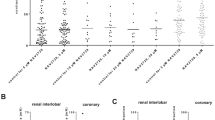Summary
Acetylcholine applied extraluminally to isolated, perfused dog mesenteric artery segments produced an endothelium-dependent depressor response when the perfusion pressure was raised by continuous infusion of noradrenaline; the potency was 1/30 to 1/60 that of intraluminal acetylcholine. Contractions induced by transmural electrical stimulation were attenuated by treatment with intra- and extraluminal acetylcholine; the inhibitory effect of intraluminal acetylcholine was greater than that of extraluminal acetylcholine. Removal of endothelium did not significantly alter the inhibitory effect. In mesenteric artery strips with endothelium, treatment with oxyhaemoglobin suppressed the relaxant response to acetylcholine but did not influence the inhibitory effect of acetylcholine on stimulation-evoked contractions. Acetylcholine reduced the 3H-overflow and contraction of superfused mesenteric artery strips, preloaded with 3H-noradrenaline, response to transmural stimulation. By the use of bioassay (dog femoral artery segment with endothelium/coronary artery strip without endothelium), the release of EDRF was first determined in the perfusate, which was introduced to dog mesenteric artery strips loaded with 3H-noradrenaline. The 3H-overflow and contraction caused by the stimulation were not attenuated by EDRF and were also observed following treatment with superoxide dismutase. Inability of the perfusate to reduce the stimulation-evoked 3H-overflow was also observed when the donor and assay tissues were treated with superoxide dismutase. It may be concluded that the inhibition by acetylcholine of the release of neuronal noradrenaline is not dependent on endothelium, Extraluminally applied acetylcholine would reach the endothelium and release EDRF, and intraluminal acetylcholine is presumed to act directly on prejunctional muscarinic receptors; however, acetylcholine appears to cross the medial layer more efficiently from intima to adventitia than in the reverse direction.
Similar content being viewed by others
References
Cohen RA, Shepherd JT, Vanhoutte PM (1984) Endothelium and asymmetrical responses of the coronary arterial wall. Am J Physiol 247:H403-H408
Cohen RA, Weisbrod RM (1988) Endothelium inhibits norepinephrine release from adrenergic nerves of rabbit carotid artery. Am J Physiol 254: H871-H878
Förstermann U, Hertting G, Neufang B (1986) The role of endothelial and non-endothelial prostaglandins in the relaxation of isolated blood vessels of the rabbit induced by acetylcholine and bradykinin. Br J Pharmacol 87: 521–532
Furchgott RF (1983) Role of endothelium in responses of vascular smooth muscle. Circ Res 53:557–573
Furchgott RF, Zawadzki JV (1980) The obligatory role of endothelial cells in the relaxation of arterial smooth muscle by acetylcholine. Nature (Lend) 288:373–376
Hongo K, Chiba S (1983) A new method for measuring vascular responsiveness of relatively larger arteries of dogs. J Pharmacol Meth 9:83–91
Ignarro LI, Kadowitz PJ (1985) The pharmacological and physiological role of cyclic GMP in vascular smooth muscle relaxation. Ann Rev Pharmacol Toxicol 25:171–191
Johnston H, Majewski H, Musgrave IF (1987) Involvement of cyclic nucleotides in prejunctional modulation of noradrenaline release in mouse atria. Br J Pharmacol 91:773–781
Loiacono RE, Story DF (1984) Acetylcholine-induced inhibition of responses to field stimulation in rabbit pulmonary artery is unaffected by endothelium removal. J Pharm Pharmacol 36:262–264
Miyazaki M, Toda N (1986) Endothelium-dependent changes in the response to vasoconstrictor substances of isolated dog mesenteric veins. Jpn J Pharmacol 42:309–316
Nakajima M, Toda N (1984) Neuroeffector actions of prostaglandin D2 on isolated dog mesenteric arteries. Prostaglandins 27:407–419
Nakazawa M, Takeda K, Nakagawa I, Imai S (1982) Contraction of the large conductance coronary artery produced by acetylcholine in the mini pig. Experientia 38:1470–1471
Okamura T, Minami Y, Toda N (1989) Endothelium-dependent and -independent mechanisms of action of acetylcholine in monkey and dog isolated arteries. Pharmacology 38:279–288
Rubanyi GM, Vanhoutte PM (1986) Oxygen-derived free radicals, endothelium, and responsiveness of vascular smooth muscle. Am J Physiol 250:H815-H821
Starke K (1981) Presynaptic receptors. Ann Rev Pharmacol Toxicol 21:7–30
Tesfamariam B, Weisbrod RM, Cohen RA (1987) Endothelium inhibits responses of rabbit carotid artery to adrenergic nerve stimulation. Am J Physiol 253:H792-H798
Toda N (1971) Influence of cocaine and desipramine on the contractile response of isolated rabbit pulmonary arteries and aortae to transmural stimulation. J Pharmacol Exp Ther 179:198–206
Toda N (1983) Isolated human coronary arteries in response to vasoconstrictor substances. Am J Physiol 245: H937-H941
Toda N, Bian K, Akiba T, Okamura T (1987) Heterogeneity in mechanisms of bradykinin action in canine isolated blood vessels. Eur J Pharmacol 135:321–329
Toda N, Minami Y, Okamura T (1988b) Regulation of the release and the action of EDRF in perfused dog arteries stimulated by acetylcholine. In: Fujiwara M, Narumiya S, Miwa S (eds) Biosignalling in Cardiac and Vascular Systems. Pergamon Press, New York, pp 3–9
Toda Y, Minami Y, Onouc H (1988a) Extraluminally applied acetylcholine and oxyhemoglobin on the release and action of EDRF. Eur J Pharmacol 151:123–126
Vanhoutte PM, Verbeuren TJ, Webb RC (1981) Local modulation of adrenergic neuroeffector interaction in the blood vessel wall. Physiol Rev 61:151–247
Yoshioka K, Furuta T, Hayakawa A, Ishikawa N, Shigei T (1988) Excitatory cholinergic innervation in canine portal and mesenteric veins. Am J Physiol 255: H288-H294
Author information
Authors and Affiliations
Additional information
Send offprint requests to N. Toda at the above address
Rights and permissions
About this article
Cite this article
Toda, N., Inoue, S., Okunishi, H. et al. Intra- and extraluminally-applied acetylcholine on the vascular tone or the response to transmural stimulation in dog isolated mesenteric arteries. Naunyn-Schmiedeberg's Arch Pharmacol 341, 30–36 (1990). https://doi.org/10.1007/BF00195054
Received:
Accepted:
Issue Date:
DOI: https://doi.org/10.1007/BF00195054



